ASRock X99 WS-E/10G Motherboard Review: Dual 10GBase-T for Prosumers
by Ian Cutress on December 15, 2014 10:00 AM EST- Posted in
- Motherboards
- IT Computing
- Intel
- ASRock
- Enterprise
- X99
- 10GBase-T
CPU Performance
Readers of our motherboard review section will have noted the trend in modern motherboards to implement a form of MultiCore Enhancement / Acceleration / Turbo (read our report here) on their motherboards. This does several things, including better benchmark results at stock settings (not entirely needed if overclocking is an end-user goal) at the expense of heat and temperature. It also gives in essence an automatic overclock which may be against what the user wants. Our testing methodology is ‘out-of-the-box’, with the latest public BIOS installed and XMP enabled, and thus subject to the whims of this feature. It is ultimately up to the motherboard manufacturer to take this risk – and manufacturers taking risks in the setup is something they do on every product (think C-state settings, USB priority, DPC Latency / monitoring priority, memory subtimings at JEDEC). Processor speed change is part of that risk, and ultimately if no overclocking is planned, some motherboards will affect how fast that shiny new processor goes and can be an important factor in the system build.
For reference, the ASRock X99 WS-E/10G has MultiCore Turbo enabled by default on BIOS 1.01A.
Point Calculations – 3D Movement Algorithm Test: link
3DPM is a self-penned benchmark, taking basic 3D movement algorithms used in Brownian Motion simulations and testing them for speed. High floating point performance, MHz and IPC wins in the single thread version, whereas the multithread version has to handle the threads and loves more cores.
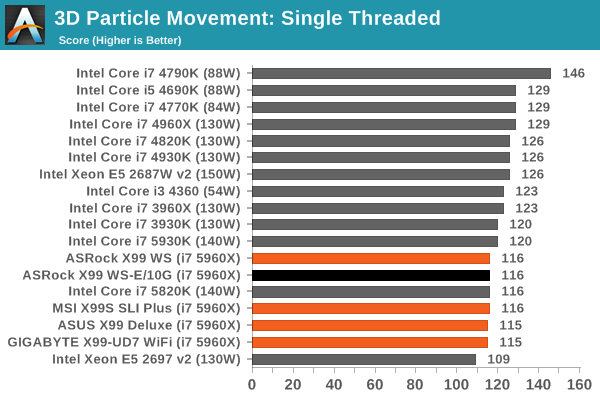
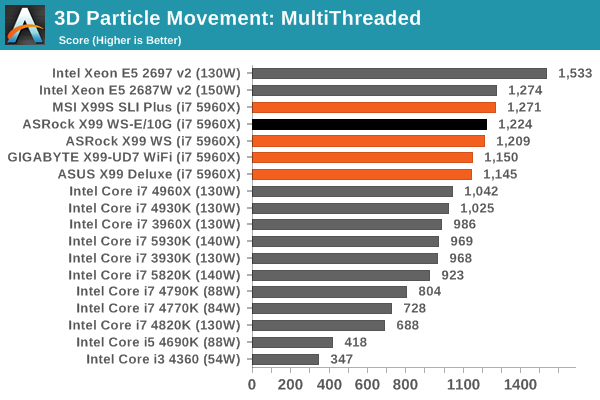
Compression – WinRAR 5.0.1: link
Our WinRAR test from 2013 is updated to the latest version of WinRAR at the start of 2014. We compress a set of 2867 files across 320 folders totaling 1.52 GB in size – 95% of these files are small typical website files, and the rest (90% of the size) are small 30 second 720p videos.
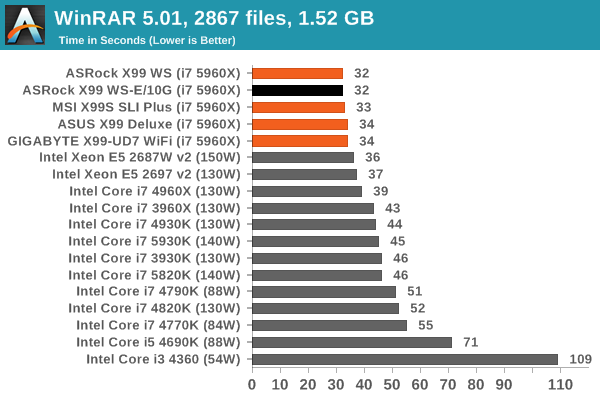
Image Manipulation – FastStone Image Viewer 4.9: link
Similarly to WinRAR, the FastStone test us updated for 2014 to the latest version. FastStone is the program I use to perform quick or bulk actions on images, such as resizing, adjusting for color and cropping. In our test we take a series of 170 images in various sizes and formats and convert them all into 640x480 .gif files, maintaining the aspect ratio. FastStone does not use multithreading for this test, and thus single threaded performance is often the winner.

Video Conversion – Handbrake v0.9.9: link
Handbrake is a media conversion tool that was initially designed to help DVD ISOs and Video CDs into more common video formats. The principle today is still the same, primarily as an output for H.264 + AAC/MP3 audio within an MKV container. In our test we use the same videos as in the Xilisoft test, and results are given in frames per second.
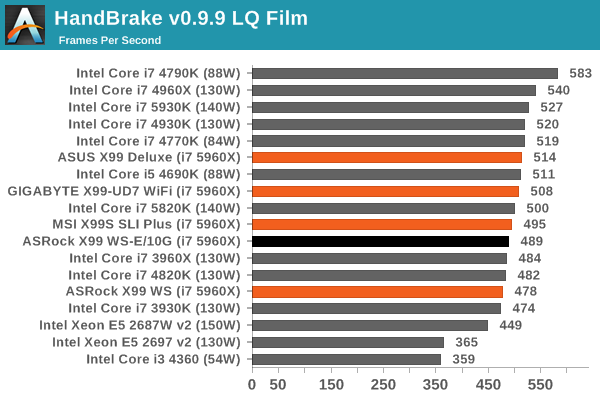
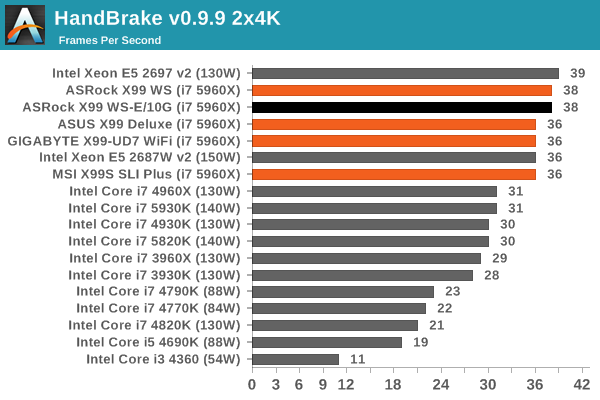
Rendering – PovRay 3.7: link
The Persistence of Vision RayTracer, or PovRay, is a freeware package for as the name suggests, ray tracing. It is a pure renderer, rather than modeling software, but the latest beta version contains a handy benchmark for stressing all processing threads on a platform. We have been using this test in motherboard reviews to test memory stability at various CPU speeds to good effect – if it passes the test, the IMC in the CPU is stable for a given CPU speed. As a CPU test, it runs for approximately 2-3 minutes on high end platforms.
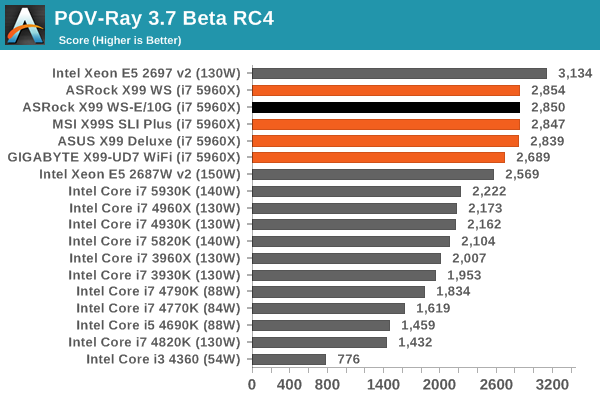
Synthetic – 7-Zip 9.2: link
As an open source compression tool, 7-Zip is a popular tool for making sets of files easier to handle and transfer. The software offers up its own benchmark, to which we report the result.
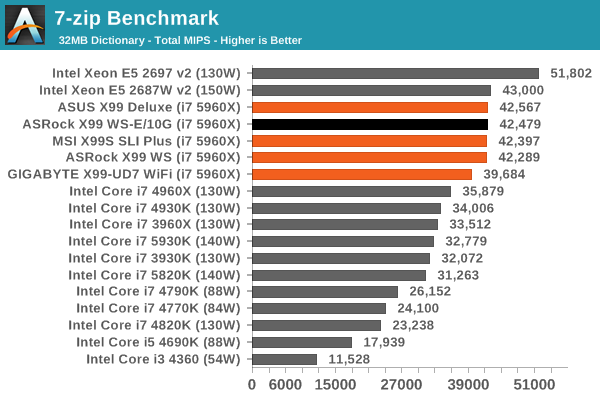










45 Comments
View All Comments
koekkoe - Wednesday, December 17, 2014 - link
One usage scenario: iSCSI storage, (especially when used also for booting) greatly benefits from 10G, because on 1G you're limited to 125MB/s, and big 16/24 disc arrays like EqualLogic can easily saturate also 10G bandwidth.petar_b - Thursday, December 18, 2014 - link
Xtreme11 used LSI SAS controller, it was awesome feature, I would happily pay for decent controller instead of slow SATA marvel ports - each time we add one more sata disk, overall disk transfer speed significantly drops. Thanks to LSI we can have 8 SSD SATA on SAS and they all perform 400MB/s even if used simultaneously. Marvel was dropping as low as 50MB/s with 8 SSD simultaneously used. What a lame.akula2 - Thursday, December 18, 2014 - link
I didn't prefer that board either -- not everything should be integrated from hardware scalability and fallback point of views. I'd prefer to build from a board such as Asus X99-E WS without filling up completely, and eventually choke it up!atomt - Saturday, December 20, 2014 - link
"It doesn't increase your internet performance"I beg to differ. 10Gbps internet is available for residential connections in my area. :-D
AngelosC - Wednesday, January 7, 2015 - link
Several things bother me with this review:1) Did I miss it or is there really no mention on how the VMs were accessing the X540? Was it running SR-IOV? Or VMXNET3? What network drivers were loaded in the VMs?
2) 10GE being the major selling point of the mobo but it was only tested using "LAN Speed Test" with results summarized into a simple chart? I suggest you could have also tested using netperf or iperf, showing results also from other OSes like CentOS? Performance difference between UDP and TCP/IP streams? If you just create packets and send, then receive packets and discard (as in the case of iperf3), you probably wouldn't have run into problem of having to place a file on a RAM disk and some other issues. And then if you ran iperf on Linux, you could have ran on bare metal, taking the VMS overhead out of the equation.
3) For sake of correctness, would you please clarify whether it was a X540-AT2 or X540-BT2?
To be frank, this review is below the standard I'd expect from AnandTech.